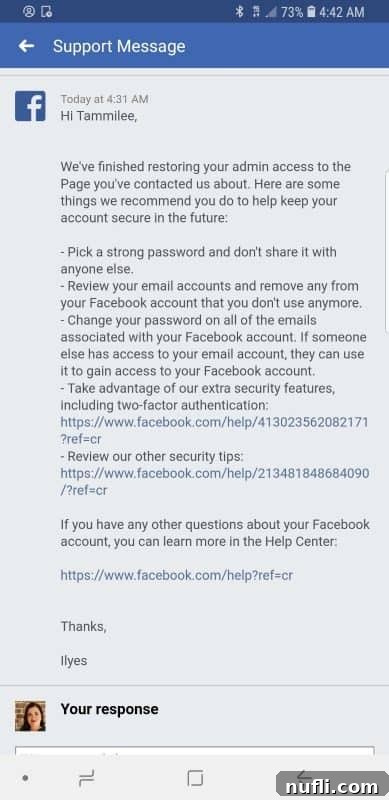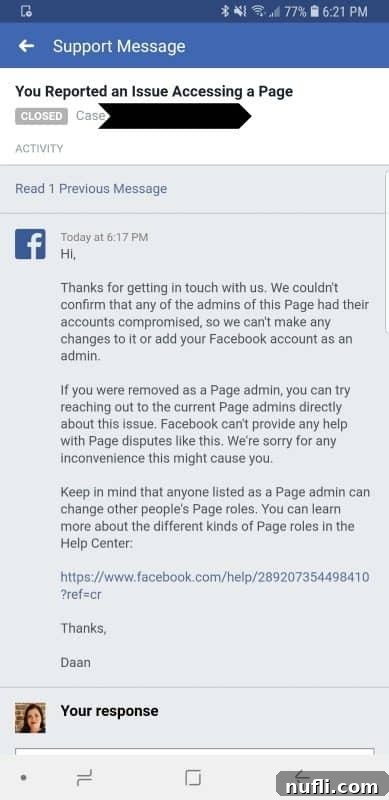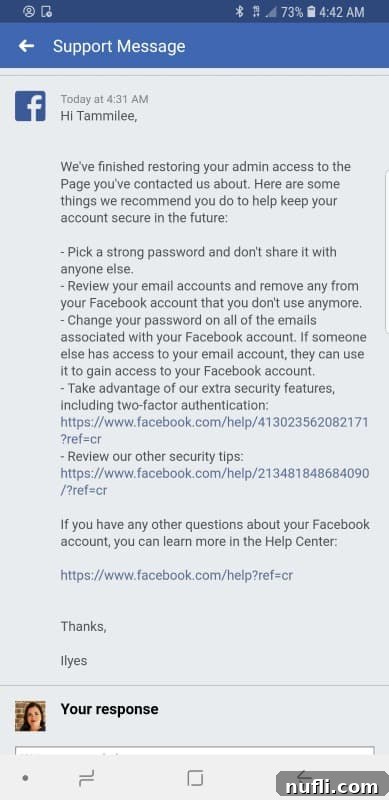There are few things more unnerving in the digital age than the sudden, chilling realization that your online presence has been compromised. For countless individuals and businesses, a Facebook Page isn’t just a social profile; it’s a vital communication channel, a community hub, and often, a primary source of income. The day I discovered my Facebook Page had been hacked was a blur of disbelief, panic, and an overwhelming sense of violation. My hope in sharing this deeply personal and frustrating journey is to equip you with the knowledge and actionable steps to prevent such an ordeal or navigate it successfully if you ever find yourself in the same precarious situation.
I wish I could recount the story of my Facebook page being hacked with a calm, composed demeanor, but the reality was anything but. It had already been one of those days that tested the limits of patience. Our home security alarm had decided to erupt well before dawn, refusing to silence despite our best efforts, leading to a frantic wire-disconnecting session just to restore peace. By mid-morning, I was already thoroughly frazzled and exhausted, clinging to the hope that the rest of the day would be uneventful.
The Unsettling Prelude to a Digital Nightmare
That hope quickly evaporated as a barrage of emails began flooding my inbox, each one more alarming than the last. They claimed someone from Pennsylvania was attempting to access my Facebook account, urging me to change my passwords immediately. After meticulously confirming their legitimacy—they were indeed from Facebook—I diligently reset my passwords, only for the emails to keep coming, relentlessly, every twenty minutes. I lost count of how many times I cycled through new passwords, desperately trying to secure my personal account. By late afternoon, a fragile sense of calm seemed to settle, and I dared to believe the threat had passed.
The illusion shattered when my husband, John, arrived home, his expression mirroring the unsettling news he carried. He had received an email informing him that he was no longer an admin on the Tammilee Tips Facebook Page. We were on our way out the door for errands when he broke the news. At first, he dismissed it as a glitch, a simple mistake. But a knot of dread tightened in my stomach. I instinctively grabbed my phone, navigating to Facebook, only to confirm my worst fears: the page was gone. Completely vanished. My heart sank as I searched, but it simply wasn’t there.
This was the moment the dam broke. I crumbled, sobbing uncontrollably, the day’s accumulated stress and this fresh, devastating blow overwhelming me. How could this be happening? On a Sunday night, no less, with no immediate recourse in sight. We abandoned our plans, rushing home to frantically search for any glimmer of hope on how to recover our disappeared page.
The Frustrating Labyrinth of Facebook Recovery
Facebook offers a dedicated contact page specifically for reporting hacked pages. With trembling fingers, I attempted to submit a report, but to my dismay, the Tammilee Tips page wasn’t even an option to select. It was as if it had been erased from Facebook’s records entirely. Thankfully, John, being another admin, was able to access the reporting function through his account and successfully flag the page as hacked.
Critical Insight #1: The Power of Multiple Admins
This experience highlighted my first, and perhaps most crucial, piece of advice: always have multiple trusted administrators on your Facebook Page. In a crisis, if one account is compromised or locked out, another admin can step in to report the issue, initiate recovery, and maintain continuity. Choose these individuals wisely, ensuring they are people you implicitly trust with full access to your digital presence.
Once a report is submitted, the excruciating waiting game begins. The silence from Facebook was deafening, amplified by the anxiety of not knowing the fate of our page. It wasn’t until the following day that a message finally arrived on John’s report. Facebook had investigated, and they were granting us access back to the page. A wave of immense relief washed over me.

I genuinely believed our nightmare was over. Eagerly, I logged back into the Tammilee Tips Facebook Page, ready to resume our normal operations. But the relief was short-lived. The hackers had left their mark, a devastating trail of destruction: over a year’s worth of meticulously created content had been deleted. Our profile photo, header image, and all contact information linking back to our website were gone. In their place, they had begun posting random recipes, redirecting traffic to an obscure, unknown site. While the content loss was agonizing, the sheer joy of regaining access overshadowed the immediate despair. I convinced myself that we could rebuild, that life would indeed be good.
I genuinely wish this was the happy ending to our story, a fairytale Facebook romance from that point forward. Sadly, that was not the case.
A Devastating Reversal: Back to Square One
The very next day, after the initial relief, a new email arrived. Facebook had “reviewed the case” again and, astonishingly, could “not confirm we owned the page.” Our access was revoked once more, and the page vanished into the digital ether. The initial shock had been replaced by a deeper, more profound sense of frustration and disbelief. This time, I was able to report the page as hacked from my own account, and I immediately began sending out emails and reaching out to every friend and contact I knew, desperately seeking any connection within Facebook.

I am convinced this reversal was an internal error on Facebook’s part. They had reviewed the page *after* we had regained control, meaning it would have appeared normal and legitimate from their perspective, inadvertently triggering a false negative in their verification process.
It was at this critical juncture that I discovered an unexpected lifeline: my Facebook ad account. For the first time during this entire ordeal, I found a way to “talk” to a live person. Through the ad account’s support chat, I explained the situation to a Facebook Ad Manager, who promised to investigate the issue and get back to me. This direct interaction, however brief, was a beacon of hope in a sea of automated responses.
Again, the waiting began. My patience was wearing thin, stretched to its absolute limit. I sent follow-up emails and requests, hoping to nudge the process along, to convey the urgency and desperation of our situation. Hours turned into a full day, and we remained in a frustrating holding pattern.
I expanded my outreach, contacting fellow bloggers and writers who might have connections at Facebook, exploring every possible avenue for help. After more than 24 hours of relentless pursuit, the breakthrough finally arrived. An email confirmed that access had been restored to our Facebook page, and the issue was resolved. The relief was immense, but it was tempered by a lingering fear that it could all be taken away again. For a cautious 48 hours, I refrained from touching the page or making any public announcements, allowing the dust to settle, ensuring the restoration was truly permanent.
Rebuilding and Reflecting: Lessons Learned from a Hacked Facebook Page
It’s been almost a week since we regained stable control, and we are back in business, but it truly feels like starting from scratch. The hackers’ actions decimated our engagement metrics by deleting a year’s worth of content. While we thankfully retained our loyal followers, the task ahead is immense – rebuilding our presence, re-engaging our community, and essentially, starting anew. This protracted and emotionally draining experience has been a profound lesson in digital resilience.
This long, winding narrative brings me to the core purpose of this article: sharing invaluable lessons gleaned from having my Facebook page hacked. While I hope you never face such a challenge, knowing what to expect and how to prepare is your best defense.
Comprehensive Guide: Protecting Your Facebook Page from Hacking & Swift Recovery Strategies
Securing your Facebook Page, especially if it’s a vital part of your business, requires proactive measures and an understanding of Facebook’s security protocols. Here’s what I learned and what you should implement:
1. Designate Multiple, Trusted Page Admins
As mentioned, this is paramount. Ensure you have at least two to three highly trusted individuals with admin access to your page. If your primary account is compromised or locked, another admin can report the hack, restore access, and prevent further damage. Choose individuals who are diligent about their own online security and fully understand the responsibilities of page administration.
2. Understand Facebook’s Official Communication Channels
When it comes to security issues, legitimate emails from Facebook will originate from “Facebookmail.com.” Be extremely wary of emails from other domains, as these are often phishing attempts designed to trick you into revealing your credentials. Furthermore, be aware that Facebook does NOT provide a public phone number for direct support. Any numbers found online claiming to be Facebook support are almost certainly scams designed to exploit users in distress.
3. Implement Two-Factor Authentication (2FA) – No Excuses!
This is arguably the single most effective step you can take to secure your account. While it might seem like a minor inconvenience to wait for a text message or use an authenticator app every time you log in, it adds an indispensable layer of security. Even if a hacker obtains your password, they cannot access your account without the second verification step. Prioritize setting up 2FA for all your Facebook accounts, both personal and for your page.
4. Regularly Review Your Security and Login Settings
Navigate to “Settings & Privacy” > “Settings” > “Security and Login.” Here, you can view all active sessions and devices where your Facebook account is currently logged in. Promptly log out of any unfamiliar devices or locations. This section also allows you to set up alerts for unrecognized logins, ensuring you are immediately notified of suspicious activity, empowering you to take swift action.
5. Utilize Facebook’s Trusted Contacts Feature
While primarily for personal accounts, this feature allows you to choose 3 to 5 friends who can help you regain access to your personal profile if you get locked out. Facebook will send them a code that, when shared with you, can unlock your account. This can be a vital backup, especially if your primary recovery methods are compromised.
6. Practice Robust Password Hygiene
If you suspect a hack, or even as a regular preventative measure, immediately change your passwords. Always use strong, unique passwords for each online account. Consider using a reputable password manager to generate and store complex passwords, eliminating the need to remember them all yourself.
7. Verify Recent Facebook Emails Within Your Account
Before clicking on suspicious links in an email, you can verify its legitimacy directly within Facebook. At the bottom of your “Security and Login” page, there’s often a tab to show all recent emails sent by Facebook. This allows you to confirm if an email claiming to be from Facebook is genuine or a phishing attempt.
8. Confirm Linked Email Accounts
Periodically check and confirm which email accounts are linked to your Facebook page and personal profile. Remove any unauthorized or unfamiliar email addresses that could be used for recovery by malicious actors.
9. Ensure Your Devices Are Secure
A compromised computer or mobile device can be the gateway for hackers. Regularly run antivirus and anti-malware software to ensure your devices are free from viruses, keyloggers, or other malicious programs that could capture your login credentials. Keep your operating system and all software updated.
10. Proving Page Ownership: A Business Imperative
For bloggers and business page owners, having a clear and indisputable way to prove your ownership of the page is critical. During my recovery, I was able to inform Facebook that I had trademarked the business name, that we operate as an LLC, and could provide legal and tax documents proving our ownership. This level of documentation proved invaluable.
Furthermore, I realized the importance of my personal presence on the page. While it might sound counterintuitive, having your face, your voice, and your personal brand frequently visible on your page can serve as powerful proof of identity. Being able to send a driver’s license or photo ID that matches the photos and videos on your page eliminates any doubt about who the true owner is and who has been diligently building the community.
Beyond Security: Diversifying Your Digital Presence
This harrowing experience was a stark reminder not to put all your eggs in one basket. It laid bare just how much of my business relied solely on Facebook and how easily it could all be lost. While Facebook remains an incredibly powerful platform, this incident underscored the critical importance of diversifying one’s online presence, building audiences on multiple platforms, and maintaining direct communication channels (like an email list) that are not reliant on a single third-party platform. It was a truly eye-opening situation that I wouldn’t wish on anyone!
If you’re reading this, please take a few minutes today to review and enhance the security of your online accounts. Set up as many security processes as humanly possible. I know that two-factor authentication and constant confirmations can feel like a nuisance, but trust me, the immense stress, tears, and potential business disruption that come with having your Facebook Page hacked are far, far worse!
As we work diligently to rebuild our engagement and restore our community, if you have a moment, please visit Tammilee Tips on Facebook and interact with a post or two. Your support as we start fresh would mean the world to us. I truly hope that we emerge from this experience stronger and more resilient than we were when it all began.
Tammilee
